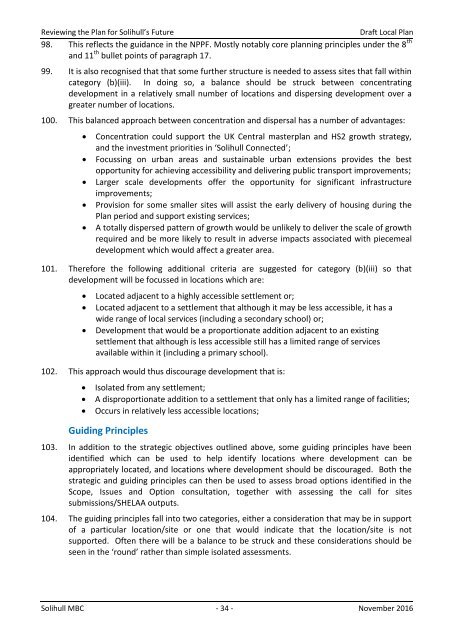Reviewing the Plan for Solihull’s Future
Draft_Local_Plan_05.12.16
Draft_Local_Plan_05.12.16
Create successful ePaper yourself
Turn your PDF publications into a flip-book with our unique Google optimized e-Paper software.
<strong>Reviewing</strong> <strong>the</strong> <strong>Plan</strong> <strong>for</strong> <strong>Solihull’s</strong> <strong>Future</strong><br />
Draft Local <strong>Plan</strong><br />
98. This reflects <strong>the</strong> guidance in <strong>the</strong> NPPF. Mostly notably core planning principles under <strong>the</strong> 8 th<br />
and 11 th bullet points of paragraph 17.<br />
99. It is also recognised that that some fur<strong>the</strong>r structure is needed to assess sites that fall within<br />
category (b)(iii). In doing so, a balance should be struck between concentrating<br />
development in a relatively small number of locations and dispersing development over a<br />
greater number of locations.<br />
100. This balanced approach between concentration and dispersal has a number of advantages:<br />
Concentration could support <strong>the</strong> UK Central masterplan and HS2 growth strategy,<br />
and <strong>the</strong> investment priorities in ‘Solihull Connected’;<br />
Focussing on urban areas and sustainable urban extensions provides <strong>the</strong> best<br />
opportunity <strong>for</strong> achieving accessibility and delivering public transport improvements;<br />
Larger scale developments offer <strong>the</strong> opportunity <strong>for</strong> significant infrastructure<br />
improvements;<br />
Provision <strong>for</strong> some smaller sites will assist <strong>the</strong> early delivery of housing during <strong>the</strong><br />
<strong>Plan</strong> period and support existing services;<br />
A totally dispersed pattern of growth would be unlikely to deliver <strong>the</strong> scale of growth<br />
required and be more likely to result in adverse impacts associated with piecemeal<br />
development which would affect a greater area.<br />
101. There<strong>for</strong>e <strong>the</strong> following additional criteria are suggested <strong>for</strong> category (b)(iii) so that<br />
development will be focussed in locations which are:<br />
<br />
<br />
<br />
Located adjacent to a highly accessible settlement or;<br />
Located adjacent to a settlement that although it may be less accessible, it has a<br />
wide range of local services (including a secondary school) or;<br />
Development that would be a proportionate addition adjacent to an existing<br />
settlement that although is less accessible still has a limited range of services<br />
available within it (including a primary school).<br />
102. This approach would thus discourage development that is:<br />
<br />
<br />
<br />
Isolated from any settlement;<br />
A disproportionate addition to a settlement that only has a limited range of facilities;<br />
Occurs in relatively less accessible locations;<br />
Guiding Principles<br />
103. In addition to <strong>the</strong> strategic objectives outlined above, some guiding principles have been<br />
identified which can be used to help identify locations where development can be<br />
appropriately located, and locations where development should be discouraged. Both <strong>the</strong><br />
strategic and guiding principles can <strong>the</strong>n be used to assess broad options identified in <strong>the</strong><br />
Scope, Issues and Option consultation, toge<strong>the</strong>r with assessing <strong>the</strong> call <strong>for</strong> sites<br />
submissions/SHELAA outputs.<br />
104. The guiding principles fall into two categories, ei<strong>the</strong>r a consideration that may be in support<br />
of a particular location/site or one that would indicate that <strong>the</strong> location/site is not<br />
supported. Often <strong>the</strong>re will be a balance to be struck and <strong>the</strong>se considerations should be<br />
seen in <strong>the</strong> ‘round’ ra<strong>the</strong>r than simple isolated assessments.<br />
Solihull MBC - 34 - November 2016


